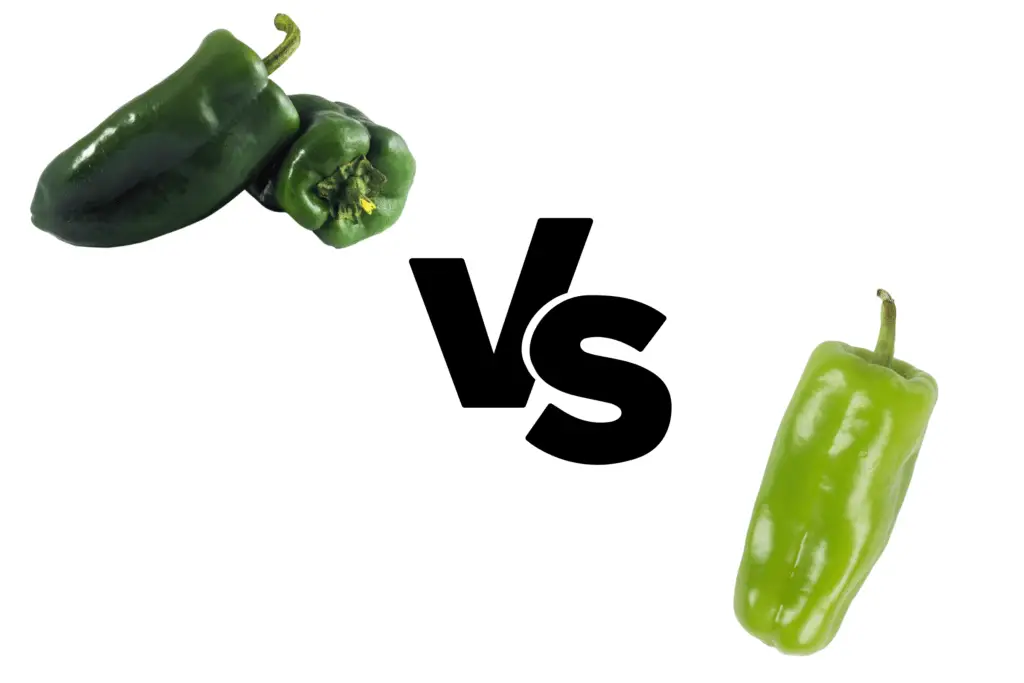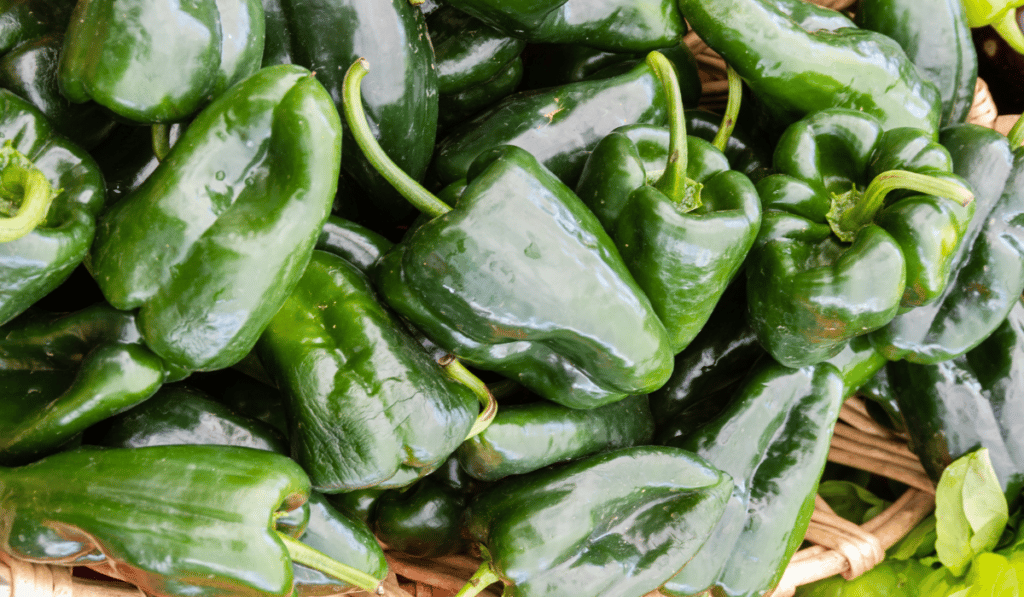Most of us are familiar with the most common peppers – bell, jalapeno – and the particularly interesting ones – such as the world’s hottest pepper, the Carolina Reaper – but what about the ones that get left behind? What’s the difference between the site-favorite poblano and the maybe lesser-known Anaheim?
Anaheim peppers have a heat range of 1,000-5,000 SHU while poblanos are typically 1,000-2,000. This means that some poblanos and Anaheim peppers may have the same heat, while some Anaheims may be as much as five times hotter than the mildest poblano. Anaheim peppers are also much longer – the longest poblano is only as long as the smallest Anaheim!
Read on for more facts about these two peppers that both deserve more attention than they receive.
Comparison – Differences between poblano peppers and Anaheim peppers
Both poblano and Anaheim peppers are great alternatives if you’re looking to add some ooomph to your salsa, hot sauce, or meals. But which one is better for your purposes? Well, it depends on what you’re trying to do.

Let’s look at the similarities and differences between poblano and Anaheim peppers based on the following criteria:
- Poblano peppers vs Anaheim peppers heat level
- Poblano peppers vs Anaheim peppers flavor
- Poblano peppers vs Anaheim peppers texture
- Poblano peppers vs Anaheim peppers size and shape
- Poblano peppers vs Anaheim peppers nutrition
- Poblano peppers vs Anaheim peppers cost and availability
- Unique difficulties
- Substitutions
| Criteria | Poblano Pepper | Anaheim Pepper |
|---|---|---|
| Heat level | 1,000-2,000 SHU | 1,000-5,000 SHU |
| Flavor | Deep, dark, smoky | Sweet and smoky |
| Texture | Smooth | Slight wrinkly |
| Size | up to 6″ | 4-6″ long |
| Shape | Relatively flat | Long and slender |
| Nutrition (per 100g) | 20 Calories 134% DV Vitamin C | 20 Calories 292% DV Vitamin C |
| Substitutions | Green bell pepper | Green bell pepper |
Poblano peppers vs Anaheim peppers heat level (in Scoville Heat Units)
At first glance, poblano and Anaheim peppers might have a similar heat level since they share a lower range.
Poblano peppers range from 1,000-2,000 Scoville Heat Units (SHU). The mildest Anaheim peppers are also 1,000 SHU, but the hottest ones can get as hot as 5,000 SHU.

This means that it’s possible to end up with a poblano and an Anaheim that have an identical SHU rating, or you could end up with an Anaheim anywhere from 2 ½ to 5 times hotter than your poblano!
Poblano peppers vs Anaheim peppers flavor
The flavor of these peppers has some similarities, but they’re certainly not interchangeable.
Poblanos have a rich, earthy, smoky flavor. Anaheim peppers have a simultaneously sweet and smoky flavor.
While these two peppers share some flavor notes, poblanos are deeper while Anaheims are more complex.
Poblano peppers vs Anaheim peppers texture
Continuing the overarching theme of the-same-but-different, these peppers have similar textures.
Anaheim peppers are slightly more wrinkly than poblanos.
That being said, they both have tough exterior skins that will need to be removed before eating.
Poblano peppers vs Anaheim peppers size and shape
While these peppers have much in common, their appearance isn’t one of them.
Poblano peppers are 4-6 inches long, and relatively flat. Anaheim peppers are much longer – usually 6-10 inches – and slender.
Poblano peppers vs Anaheim peppers nutrition
Both poblano and Anaheim peppers are low in calories and high in Vitamin C, a powerful antioxidant with potential anti-cancer properties.
Poblano peppers vs Anaheim peppers cost and availability
Poblanos are much easier to find than Anaheim peppers, so they cost less.

Anaheim peppers are less popular and well-known, but you may be able to find them at specialty grocery stores or even a local farmer’s marker.
Unique difficulties
The main difficulty with cooking with poblanos is their tough outer skin. Some people don’t mind it, but most choose to roast the pepper and peel the skin off before consuming or cooking with the pepper.
While Anaheim peppers also have thicker skin than most peppers, your real concern with these peppers is likely to be the wide SHU range! The hottest Anaheim pepper is 5 times as hot as the mildest type of this pepper.
Can you substitute poblano peppers for Anaheim or vice versa?
Poblano peppers and Anaheim peppers both have a smoky element to their flavor, but you still need to be careful if you want to substitute one for the other.
If you can identify that the pepper you’re choosing has a similar heat to the one being substituted for, the switch may work. You can probably get away with substituting a spicy poblano for a mild Anaheim.
Anaheim peppers also have a sweetness that may or may not be welcome in your recipe.
Poblano peppers – a complete overview
Poblano peppers are a mildly spicy pepper from Puebla, Mexico. They’re often grilled or roasted and are a favorite among gardeners because they’re relatively easy to grow, yield a bountiful harvest, and are just plain delicious.
Let’s take a look at the specific characteristics of this versatile pepper!
Heat
Poblano peppers range between 1,000 to 2,000 SHU. In other words, they’re mildly spicy.
Fully mature poblanos are twice as hot as “immature” poblanos. Immature poblanos are dark green and turn deep red as they mature.
Capsaicin continues to increase as poblanos – and all hot peppers – age. This is why more mature peppers are spicier!
Flavor
Poblano peppers are often considered a more grown-up version of a green bell pepper.
Poblano peppers are deep, rich, smoky, and earthy. Many people roast these peppers to remove the thick outer skin, but it also serves to mellow the flavor.

They have more of an umami flavor than most other peppers.
Size, shape, and texture
Poblanos have a tough outer skin that some people prefer to peel before use. This prevents a lot of people from using poblanos raw.
Poblanos look like flattened bell peppers and range from 4 to 6 inches long.

Nutritional content and potential health benefits
Some potential health benefits of poblano peppers include:
- Longer lifespan due to high antioxidant content
- Capsaicin decreases inflammation
- Vitamin C boosts immunity
One raw cup of poblano peppers has:
- 20 calories
- 147% DV Vitamin C
- 6.2% DV dietary fiber
Cooking with poblano peppers
Poblano peppers are much-loved, especially in Mexican-inspired cuisines, for their deep flavor and mild spiciness. Unless you’re completely opposed to spiciness, you can probably handle a poblano.
Blistering poblano peppers is arguably the best complement to their deep, rich flavors. Otherwise, poblanos are often roasted, sauteed, or grilled. Poblanos are also commonly stuffed because of their size and sturdiness.

Some people enjoy raw poblanos with hummus, while others find them too tough.
Substitutions for poblano peppers
Green bell peppers are the best substitute for poblano peppers.
That being said, they’ll lack the heat and flavor profile.
Freezing, drying, and preserving poblano peppers
Freezing, drying, and pickling poblano peppers are all popular ways to extend their shelf life.
Anaheim peppers – a complete overview
Anaheim peppers are named for the city in California where they were planted in the early 1900s, but they’re so common in New Mexico that they’re simply referred to as chiles there. It’s worth noting that the California variety of this pepper isn’t as hot as the ones grown in New Mexico.
Let’s dive into all the important qualities of Anaheim peppers!
Heat
Anaheim peppers are considered a mild pepper, but they can catch you off guard if you’re expecting something on the more mild side of the scale!
Anaheim peppers have a SHU rating between 1,000-5,000. The more mature the pepper is, the hotter it will be.
They can be used “ripe or unripe.” Anaheim peppers turn dark maroon as they mature.
Flavor
Anaheim peppers are simultaneously sweet and smoky, leading to a complex flavor profile.
Size, shape, and texture
Anaheim peppers look like long jalapenos with slight wrinkles.

In fact, they can reach nearly a foot long, averaging between 6-10 inches!
Nutritional content and potential health benefits
Per one pepper, Anaheim peppers notably have:
- 13 calories
- 86% DV Vitamin C
Vitamin C is a strong antioxidant that helps fight free radicals in your body. In addition, the capsaicin content may be anti-inflammatory.
Cooking with Anaheim peppers
Anaheim peppers are most popularly used stuffed.
That being said, they can also be grilled, roasted, or sauteed.
Substitutions for Anaheim peppers
Anaheim peppers have a great, broad flavor profile which means you can substitute a wide variety of peppers if you’re not particularly worried about the heat level.
Poblano peppers actually make for a good substitution for Anaheim peppers if you’re looking for smokiness.
Meanwhile, jalapenos bring sweetness and heat – although they are 2,000-8,000 SHU and may overwhelm your recipe if you were planning on a milder Anaheim pepper.
While you will lose a good bit of flavor and all the heat, green bell peppers will make an adequate (and easy to find) substitute in a pinch.
Freezing, drying, and preserving Anaheim peppers
Some good ways to preserve Anaheim peppers include freezing, drying, canning, and pickling them.
One popular method is to dry them and then grind them up and use them as chili powder!

